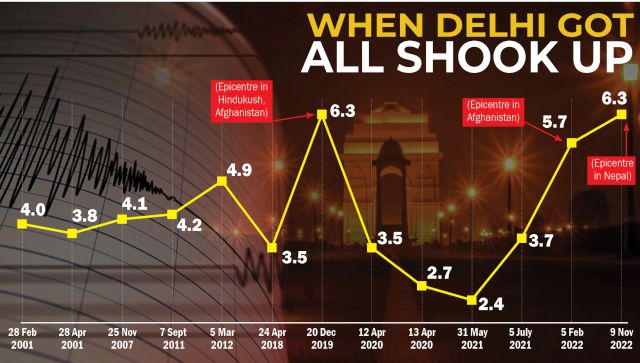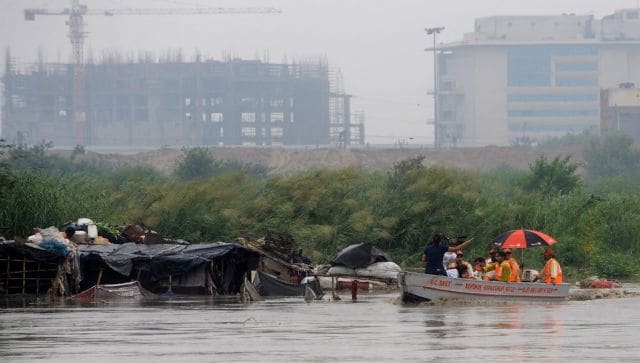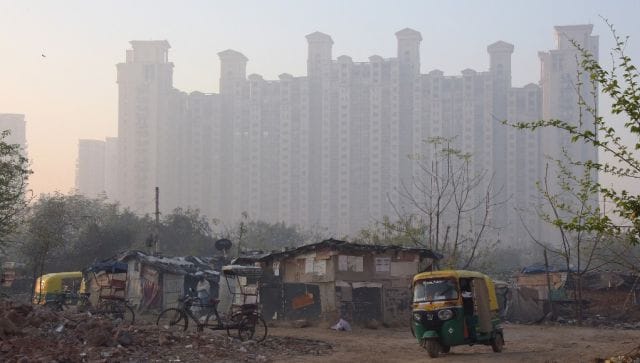Is there a big earthquake in Delhi? | Tech Reddy
[ad_1]
A night that shook Delhi. After a magnitude 6.3 earthquake struck Nepal, strong tremors were felt in the capital and surrounding areas around 2 am. They lasted about 10 seconds, prompting many to evacuate their homes.
Tremors were also felt in Gurugram, Noida and other parts of Uttar Pradesh. A few hours later, an earthquake struck Pithoragarh in Uttarakhand.
While no casualties were reported in India, six people lost their lives in Doti districts of Nepal.
Also Read: From Nepal to China, Deadliest Earthquakes to Rock the World
Tremors in Delhi-NCR, Uttarakhand
An earthquake struck Nepal around 1.57am on Wednesday, the third in five hours. According to the National Center for Seismology, the first of magnitude 4.9 was recorded at 8.52 pm on Tuesday followed by magnitude 3.5 at 9.41 pm.
The third earthquake, 6.3 on the Richter scale, struck at 1.57 am, with tremors felt in the Delhi-NCR region. The National Center for Seismology tweeted, “Magnitude: 6.3 Earthquake, November 9, 2022, 01:57:24 IST, Latitude: 29.24 and Longitude: 81.06, Depth: 10 km, Location: Nepal”.
It didn’t end there. Another 4.3 magnitude earthquake hit Uttarakhand’s Pithoragarh at around 6.27 am on Wednesday. According to the National Center for Seismology, the depth of the earthquake was 5 km underground.
The tremors sent panic across Delhi and other parts of northern India, leaving many people out of their homes for hours.
However, this is not the first earthquake in the Delhi-NCR region. Between September 2017 and August 2020, a total of 745 earthquakes were recorded by the National Seismological Network, including 26 events of magnitude three and above in the National Capital Region (NCR).
In 2021, the Delhi-NCR region experienced at least five tremors due to low-intensity earthquakes or aftershocks.

Graphic: Prannoy Bharadwaj
Delhi ‘intense’ seismic zone
But why so much vibration in Delhi?
The capital and its surrounding cities fall in high-risk seismic zones. The Bureau of India Standards has classified the country into four main zones — Zone V (High Intensity) to Zone II (Low Intensity) based on the Macro Seismic Zoning Map of India.
Delhi and parts of northern Uttar Pradesh fall in Zone IV, the severe category. Bhuj in Gujarat, which was hit by a massive earthquake in 2001 that killed 20,000 people, Chandigarh, Ambala, Amritsar, Ludhiana and Roorkee all fall under zones IV and V, reports Economic Times.
Delhi lies close to three active seismic fault lines: the Sohna fault line, the Mathura fault line and the Delhi-Moradabad fault line. Gurgaon lies on seven fault lines, making it the most vulnerable area in Delhi NCR. If these are activated, it could trigger a magnitude 7.5 earthquake, the report said.
According to earthquake engineering expert IIT-Jammu Professor Chandan Ghosh, earthquake epicenters are changing as the environment changes. Tectonic plates are shifting. “Delhi is close to the Himalayas, which were formed by the mixing of tectonic plates like India and Eurasia. Due to the movement of these plates, areas like Delhi-NCR, Kanpur and Lucknow are more prone to earthquakes.”

Graphic: Prannoy Bharadwaj
Although the region is experiencing tremors and aftershocks, one of the major earthquakes recorded in Delhi was more than six decades ago. On August 29, 1960, an earthquake along the Delhi-Gurgaon border shook the capital.
About 75 percent of the buildings around the epicenter suffered cracks, and minor damage was reported to the Red Fort and Rashtrapati Bhavan. About 100 people were injured in the rubble and stampede. The magnitude of the earthquake was 6 on the Richter scale, but later researchers said it was 4.8, a report said. Economic Times.
If there is an earthquake in Delhi-NCR today
Experts say that there is continuous seismic activity in the NCR region, which can cause major tremors. It doesn’t help that many parts of Delhi and surrounding areas are highly populated.
The border towns of Delhi have seen an increase in high-rise private buildings many of which do not follow the mandatory guidelines set by the Bureau of Indian Standards (BIS) for earthquake-resistant construction. Numerous illegal colonies across the capital and rickety constructions along the Yamuna would be unable to withstand a strong tremor.
“At 6.0 on the Richter scale, the impact of an earthquake in Delhi will be devastating. Many buildings will be reduced to dust,” said Professor Chandan Ghosh Business Standard In June 2020, after ten low-to-moderate-intensity tremors were recorded in the Delhi-NCR region over a period of one-and-a-half months.
“Everyone knows that Delhi-NCR falls under Seismic Zone-4 and is prone to tremors but still most builders do not follow BIS norms. Architects and builders have a relationship that somehow compromises strict earthquake (resistant) codes. So, any day, if a high-magnitude earthquake occurs here, the consequences will be dire,” the professor added.

The Yamuna and its flood plain areas will be the worst hit if an earthquake hits the Delhi-NCR region. AFP
In 2005, the Delhi government approved a US-aided project to retrofit some of its buildings with earthquake protection, including the secretariat and police headquarters. But the project remains incomplete, according to a report in Outlook.
Most of the structures in India are built to prevent collapse in case of a major earthquake but this does not ensure that the structure survives the disaster and can be reused immediately.
Most dangerous places in Delhi
According to a report on “Seismic Hazard Microzonation” of Delhi released by the Ministry of Earth Sciences, most of the areas along the Yamuna and its flood plains, including the highly populated colonies of East Delhi, will be the worst hit. Strong earthquake.
The Lutyens area, which houses Parliament, Union ministries and other important structures, falls under high-risk zones including Delhi University’s North Campus, Karol Bagh, Janakpuri, West Bihar and Rohini. Delhi Airport and House Khaj fall in the second worst “high-risk category”.
Earthquake forecasting
The region around Delhi has the highest number of seismometers anywhere in the country – 16 out of 115 installed in India. Thus, even a small magnitude earthquake is recorded. However, it may not help predict a major earthquake.
“There can still be major earthquakes. No one can deny it. But they cannot be predicted. So it is completely unscientific to call these small earthquakes precursors of big earthquakes,” said Harsh Gupta, one of India’s earthquake experts and former director of the National Geophysical Research Institute. Indian Express.

According to experts, most of the buildings in Delhi and Gurugram are not earthquake-proof. AFP
He also said that small tremors help release energy in bits that don’t require a major earthquake. “The Delhi area has experienced magnitude five to six earthquakes, but fortunately not in the last 50-60 years… You would need 1,000 magnitude 4 earthquakes to release the equivalent energy of a magnitude 6 earthquake. These arguments have no basis,” he told the newspaper.
with input from organizations
read all latest news, Trending news, cricket news, Bollywood news,
India News And entertainment news Here. Follow us on Facebook, Twitter and Instagram.
[ad_2]
Source link


